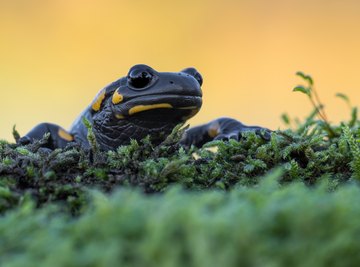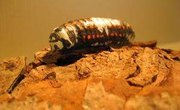
Skinks make up the largest family of lizards and inhabit every continent, except Antarctica. They are reptiles and their skin is covered with smooth, shiny scales. Salamanders, which are found in temperate regions worldwide, are amphibians and have a moist, permeable skin. Skinks hatch as miniature replicas of their parents, while the young of salamanders hatch as larvae from eggs that are laid under water.
Skin
Skinks have smooth skin made up of shiny, overlapping scales. The highly polished dorsal, or back, scales, often appear iridescent. Some species have a transparent scale across the lower eyelid, which allows the animal to see even when the lid is closed. Many skink species have stripes, but these reptiles may also have spots or bands. Some types have a uniform color.
Salamanders have a soft and delicate skin, which needs to remain moist. Salamanders secrete mucus which maintains their salt balance while in water and keeps their skin moist when on land. These amphibians also have poison glands in their skin and are usually brightly colored as a warning to potential predators.
Body Shape
Skinks have cylindrical bodies and cone-shaped heads. The males in some skink species develop visibly broader heads than the females. The majority of species are small and do not exceed 8 inches in overall length. The Solomon Island giant skink however, can grow to 24 inches in length. The tapering tail of most skink species breaks easily, but is easily regenerated. Some burrowing species are limbless.
Salamanders have long bodies and tails and blunt faces. These amphibians range in size from just over an inch in length, to the 6-foot Chinese giant salamander, which is the largest of all amphibians.
Habitat and Habits
Skinks are active during the day but tend to remain hidden under leaf litter, bark or rocks as they look for food. They are primarily ground-dwelling, but certain species live in trees. Salamanders are generally nocturnal and live in or near water. They hunt for insects on the damp forest floor or in cool, moist caves and remain hidden under moist leaf litter and in logs during the day.
Diet
The majority of skinks are insectivorous, but select species are partially or totally herbivorous. The plant-eating types have wide, grinding teeth. Some species also prey on lizards and mice. Adult salamanders are usually carnivorous. They prey on a variety of insects, frogs, fish and other salamanders. Salamander larvae hunt tiny aquatic creatures.
References
Resources
About the Author
Virtually growing up in a computer repair shop, Naomi Bolton has held a passion for as long as she can remember. After earning a diploma through a four year course in graphic design from Cibap College, Bolton launched her own photography business. Her work has been featured on Blinklist, Gameramble and many others.
